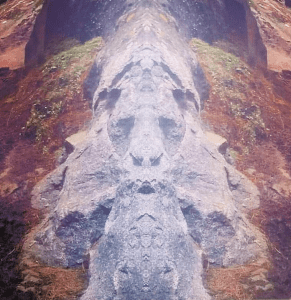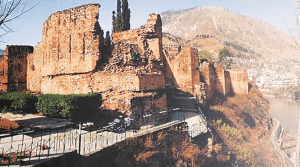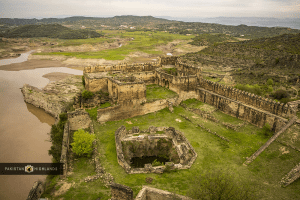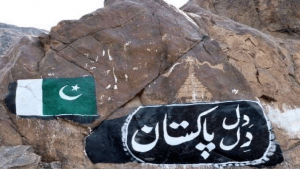Archaeological sites/monuments of Pakistan Occupied Kashmir (PoK)
Kargah Buddha

- Located off Gilgit, this seventh-century archaeological site comprises a carved image of a large standing Buddha on the cliff in Karghah Nala.
- From the 3rd century to the 11th century, Gilgit was a Buddhist centre.
- A few metres away, a Buddhist monastery and three stupas containing Sanskrit manuscripts were also found during an excavation in 1931.
Ali Baig gurdwara

- A popular place of worship for Sikhs in Ali Baig village, the gurdwara was turned into the Muhammad Yaqoob Shaheed High School for Girls, as per a report by Pakistani archaeologists during the 2014 study.
Fountains and Gardens of Khuiratta
- Khuiratta and its surrounding areas are very popular among local tourists, with the shrine of Mai Totti Sahiba a venue for an annual three-day fair.
- People from Kotli and other adjoining districts attend the festival in spring to watch sports, animal parades and horticultural displays.
- The area has a number of natural springs and waterfalls.
- It is believed to have been an important place of worship for Hindus during ancient times.
Red Fort, Muzaffarabad

- Known among the locals as Rutta Qila or just qila, this site in Muzaffarabad was built by the Chak rulers, who anticipated threat to the city from the Mughals.
- The construction began in 1559. However, the Mughals annexed Kashmir in 1587, and the fort lost its importance.
- Later, its construction was completed in 1646 by Muzaffar Khan of the Bomba Dynasty, the founder of Muzaffarabad.
- Its architecture shows great craftsmanship, but most of the fort’s relics were stolen and a large portion was destroyed during the 2005 earthquake.
Ramkot Fort

- It is located on a hilltop on the banks of the Mangla Dam lake.
- The three sides of the hilltop are surrounded by the Jhelum River, which falls into the huge reservoir of Mangla Dam.
- It was built in the 16-17th century by a Gakhar named Toglu as recorded by traveller and geologist Frederick Drew in his book.
- Gakhars were a clan from the region renowned for their skill in building forts and fortified cities.
Sharada Peeth

- The much-revered Hindu temple, located in the Neelum Valley, is an ancient centre of learning dedicated to the Hindu goddess Sharada.
- There used to be an annual pilgrimage by Kashmiri Pandits to Sharada Peeth, but it was stopped after Independence.
- The temple-university played a key role in the popularisation of the Sharada script in North India, and Kashmir was sometimes called Sharada Desh because of its influence as a centre of learning.
- Its origins are uncertain — while some historians believe it was built under the Kushan Empire in the first century, others say it was built by Lalitaditya of the Karkota dynasty.
Sharada script
|
Why in News?

India has reacted strongly to reports of vandalism and defacement of ancient Buddhist rock carvings in Gilgit-Baltistan under Pakistan’s control.
News in detail
- The incident has brought focus on the priceless Buddhist heritage of Gilgit-Baltistan found in the rock carvings and engravings especially in areas like Hunza which were part of the Buddhist circle covering Ladakh and Tibet.
- The engravings have been in the news recently also because of the Diamar-Bhasha hydro power project that the Chinese and the Pakistani companies will construct nearby.
References:
https://indianexpress.com/article/india/pakistan-occupied-kashmir-cultural-heritage-sites-6037466/
https://www.britannica.com/topic/Sarada-script
https://pakistanhighlands.com/ramkot-fort/
https://www.dnaindia.com/india/report-pak-mulls-opening-sharada-peeth-corridor-inside-pok-2733274
Subscribe
Login
0 Comments
